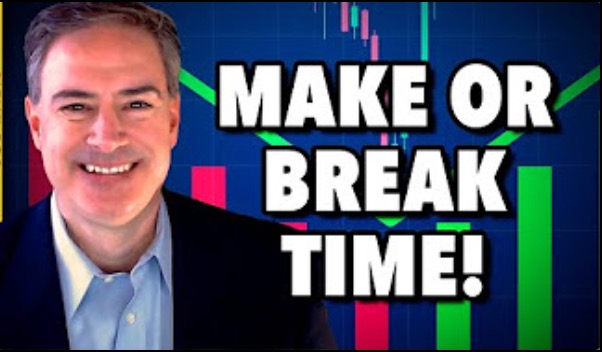What will the stock market look like in 2023? It’s hard to say, but these five charts could take your market awareness up a few notches.
Predicting stock price movements is never easy, even for the most seasoned stock investor. The closest you can come as an investor or trader is to keep track of a handful of charts that help provide an overall view of the stock markets and be aware of the internals of the market. But which charts should you watch?
David Keller, CMT, our Chief Market Strategist, discussed his top 5 charts for 2022 on his StockCharts TV show The last bar. And the charts he uses could be on your top 5 list by 2023. Which charts make it onto Keller’s top 5 list? let’s find out
The TL;DR
- S&P 500 index with Fibonacci retracement levels
- 10-year US Treasury Yield Index
- US Dollar Index vs. Gold and Crude Oil
- A mega-cap stock
- The graphicwhich is a combination of a broader index and sentiment indicators to identify potential turning points in the stock market.
A deep dive into the top charts
One of the challenges of keeping track of stock markets is that there are many moving parts. These five charts show you what’s happening in key areas of the financial markets and alert you when investor sentiment might be changing.
Bonus gift: Access the top 5 charts here. Save them to your ChartLists and follow them.
#1: S&P 500 index with Fibonacci retracement levels
It goes without saying that the S&P 500 Index ($SPX) is one of the most talked about charts when it comes to the stock market. Money managers use it as a benchmark, but other than that it’s good for getting a broad view of the market. And when you add the Fibonacci retracement levels (Fib levels) to the $SPX chart, you can identify areas of support and resistance levels and areas where investor behavior is changing.
Access the chart from the link above and starting from the March 2020 low, see how $SPX has reacted to the various Fib levels. You may notice that there is a second set of Fib retracement levels from the September 2020 low to the January 2021 high. Both sets help identify potential turning points in $SPX.
How to add Fibonacci retracement levels
- View a chart of any stock, index, or exchange-traded fund (ETF).
- Choose Leave a Comment.
- Select the Fibonacci Arcs icon > Fibonacci Retracement
- Select a high or low point, hold the mouse pointer and drag to the low or high point to the right of your original point.
- When you are happy with your high and low points, release the cursor, select the X in the top right of the chart and save the chart.
In 2023, the 3800 level will be a key level to watch. If $SPX goes down, the next level would be 3500 and below that would be 3200. “The bottom isn’t necessarily in for the current market cycle,” noted Dave. “January is typically the weakest month of the year and first and second quarter gains can impact overall markets. So maybe the $3200 level in the SPX is possible.”
#2: 10-year US Treasury Yield Index
Inflation is at the center of every investor’s mind, and more rate hikes are likely in 2023. Interest rate decisions affect stock markets, especially when it comes to growth and value stocks. “When interest rates are rising, value stocks tend to outperform, and when interest rates are falling, growth stocks tend to outperform,” Keller added. For this reason, it makes sense to compare the 10-year US Treasury Yield Index ($TNX) to the performance of growth stocks and look at the overall shape of the yield curve.
Access to the dynamic yield curve
- Of your dashboardscroll down to charting tools in Member Tools.
- Choose Dynamic Yield Curve.
- View a snapshot or animate the chart to see the changes in the yield curve.
The dynamic yield curve helps to see if the curve is steep, flat or inverted.
Interest rates are likely to rise in 2023, meaning bond and stock prices are likely to fall. But it’s possible that other themes will be similar to what they were in 2022 – as the $SPX was trending lower, the energy sector did well earlier in the year and industrials and materials performed well later in the year.
This second chart can help you identify whether value stocks are outperforming growth stocks. Depending on the leadership topic, you could invest accordingly.
#3: US Dollar Index vs. Gold, Crude Oil
Intermarket analysis shows how different assets – stocks, bonds, commodities and currencies – are related. Understanding these relationships can provide additional market insights. For example, when stocks are trending down, investors are likely to invest in risk-free assets like gold.

Crude oil prices may affect consumer behavior – higher oil prices could reduce driving and travel, which in turn may affect the performance of the airline industry. A stronger dollar could benefit US equities but hurt global companies’ earnings. Understanding the relationships between the various assets can help you identify when a change is occurring.
Looking at the third chart, keep the following in mind:
- Will the US dollar return to its mean or continue to rise?
- Will Gold Continue or Reverse its Upward Move?
- Crude Oil Staying In Its Downward Channel?
“Intermarket relationships help you analyze trends, determine probabilities, and position yourself for what you think is the optimal scenario,” added Dave. “More importantly, investors should plan for risk because all big losses start out as small losses.”
#4: A mega-cap stock
It’s always a good idea to follow one of the mega-cap growth stocks. For 2022, Keller decided to analyze Alphabet (GOOG) stock for the following reasons:
- During the post-COVID upleg, FAANG stocks dominated during the upleg. If you look at any of these charts, you will see that they show similar movement.
- In the GOOG chart you can clearly see the rotation from the up lead to the down lead.
- You can identify three of the key investing characteristics – spotting trends, following trends, and anticipating when trends are exhausted.
Adding price performance versus the SPDR S&P 500 ETF (SPY) helps see how GOOG is performing relative to the benchmark. On the chart you can see how different technical scenarios play out.
- The 50-day moving average (MA) is below the 200-day MA.
- A divergence between the Relative Strength Index (RSI) and the price from September to December 2021.
- A break below the early 2022 support level.
- A lower RSI area during the bearish phase.
“This chart helps to see how the investment picture has changed, how signals have turned and what levels have been established or broken,” noted Dave. “It helps you understand how to apply risk management so you’re better prepared for the next boom-and-bust cycle.”
The mega-cap stock you pick for 2023 may be different depending on which sector is performing well and which stock is the leader in that particular sector. There are several ways to determine the broad participation of sectors, which is why the next chart is important.
#5: The graphic
The fifth chart is a series of different charts looking at market internals. The chart above may vary based on prevailing market conditions. For 2022, $SPX made it to the top of the podium. Below the line chart of $SPX is NYSE common stock Progress/Rejection linePercent of stocks above their 50-day MA, S&P 500 bullish percentage index, and the ratio of consumer discretionary to consumer staples. Scroll below the diagrams to see how to recreate this setup.
A few things to keep in mind:
- The clear downtrend line in $SPX.
- From December to January 2021, $SPX made higher highs while the NYSE common stock AD line made a lower high. This was an early sign that the uptrend might be exhausted.
- See if the percentage of stocks above their 50-day MA is above or below the 50% level. If $SPX is making higher highs but this indicator is below the 50% level, it should be a red flag.
- For the Bullish Percentage Index, look for extreme levels of market breadth – above 70 or below 30.
- The ratio of consumer discretionary to consumer staples is a measure of the overall stability of the market. It gives you an idea of whether investors are leaning towards offensive or defensive strategies. You will see on the chart that this indicator failed to provide a confirmatory signal during the $SPX January 2022 high.
“This chart looks at three key points — price, breadth, and leadership — that help gauge attitudes between risk-taking and risk-avoidance. When all of these indicators align, that is an indication that change is afoot,” concluded Dave.
Looking to 2023
Now that you have the top 5 charts by 2023, what should you look out for? Here are a few pointers:
- Look at the 3500 and 3200 Fib levels in $SPX. There could be buying opportunities at these levels.
- Will $TNX move down towards its 200-day ma?
- Will gold continue to rise?
- Watch out for rotations in large-cap stocks.
- Watch for a break in the $SPX downtrend line and see if this is confirmed by the AD line, the percentage of stocks above their 50-day MA and the bullish Percent Index. This will help determine if investors are moving towards risk-on investment strategies.
The bottom line: There’s no holy grail when it comes to predicting stock price movements, but these five charts will help you stay alert to potential market changes. While some themes like higher interest rates are likely to persist in 2023, the market is known for its ability to surprise. Be prepared to be unprepared.
Happy Holidays from the StockCharts team.

Jayanthi Gopalakrishnan
Director, Website Content
StockCharts.com
Disclaimer: This blog is for educational purposes only and should not be construed as financial advice. The ideas and strategies should never be used without first assessing your own personal and financial situation or without consulting a financial professional.
Happy charting!

Jayanthi Gopalakrishnan is Director of Site Content at StockCharts.com. She spends her time creating content strategies, providing content to educate traders and investors, and finding ways to make technical analysis fun. Jayanthi was Managing Editor at T3 Custom, a content marketing agency for financial brands. Prior to that, she was Managing Editor of the journal Technical Analysis of Stocks & Commodities for over 15 years.
learn more





